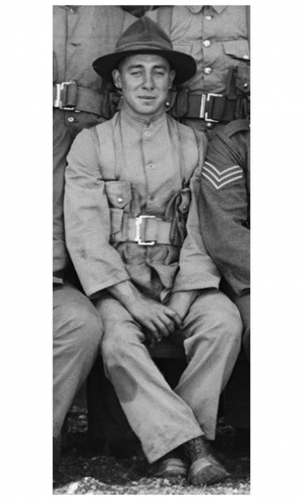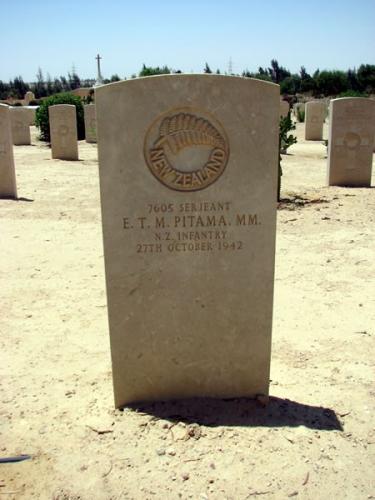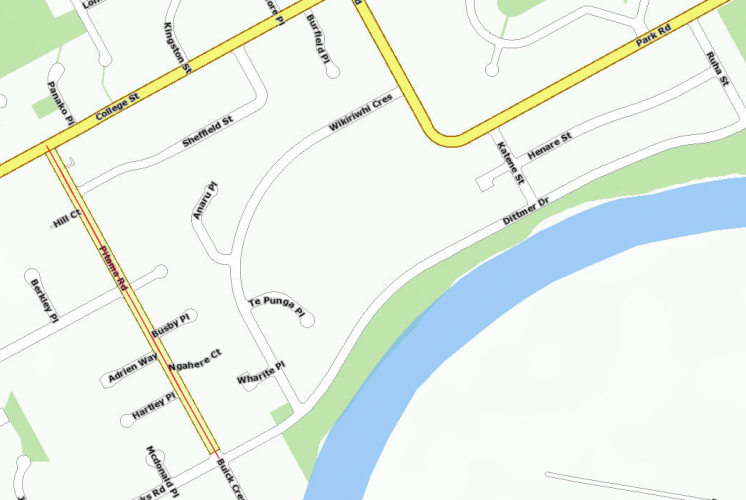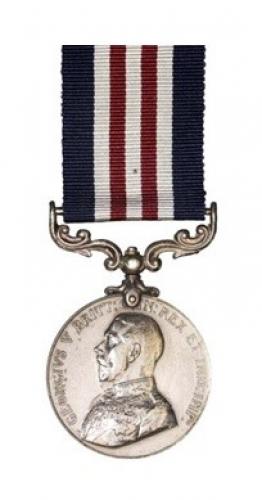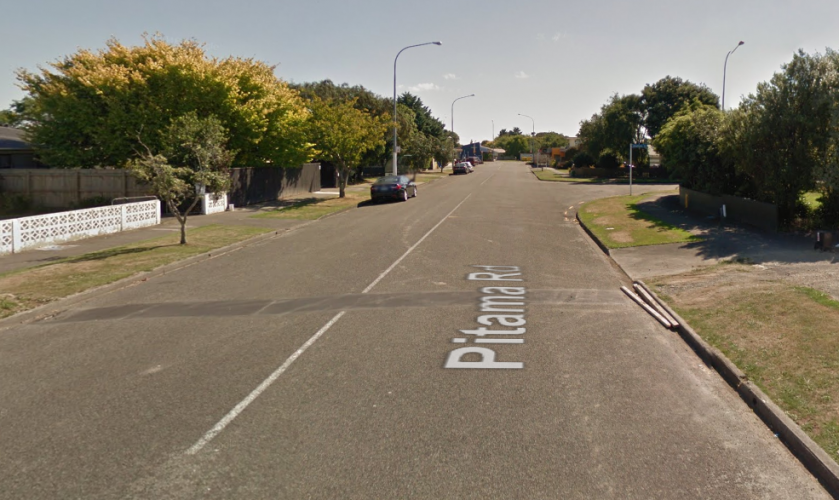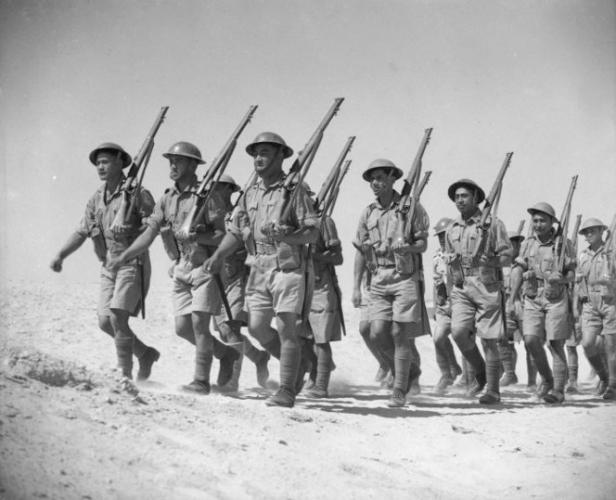091 Pitama Rd Palmerston North, street scene 2017
Reason for the name
This street was named in honour of Sergeant Eutahi Tahu Mataa Pitama, 28th Maori Battalion
Prior to its subdivision the land known as Awatapu was a golf course and grazing area situated next to the Manawatu River. In order to free up land for residential development and increase revenue, a Council meeting of 16 April 1963 resolved to subdivide the area via “disposal of sections through Land Agents at pre-determined figures fixed by the Council. The new Awatapu College had to be allowed for, and the old Awatapu Golf Links shifted upstream to Brightwater Terrace, which then became the Palmerston North Golf Club. The main access road through the area was at first known as Awatapu Avenue.
As part of the process of subdividing and naming streets, George Dittmer was contacted in late 1964 to give his thoughts on the naming of streets after 28th Māori Battalion soldiers as a commemoration of their service to their country. Dittmer provided a comprehensive list of soldiers who had served under him which was later utilised by the Council to adopt further street names in the Awatapu subdivision. After consultation and further correspondence with the Palmerston North City Council it was decided that the new streets in the area would be renamed in honour of them. The resolution was passed by Council on 22 November 1965 and took effect from 1 February 1966.
While the Awatapu area was being redeveloped the existing Melford Road bounding it to the west was widened and resealed in anticipation of increased traffic. In order to keep uniformity with the general area and the recently redeveloped Awatapu subdivisions it was decided that the road would be renamed after these works were completed. In addition, correspondence between residents and the Council revealed that having Melford Road running off Long Melford Road was too confusing for locals and visitors alike. As a result, on 26 April 1966 the renaming of Melford Road to Pitama Road was confirmed by the Council.
Pitama Road is a primarily residential area in the southwest quadrant of Palmerston North which runs in a north-south direction, bounded by College Street in the north and converging into Buick Crescent at its southern end near the Manawatu River. There are multiple streets and cul-de sacs running off it, including Sheffield Street, Hill Court, Anzio Place, Long Melford Road, Busby Place, Adrien Way, Ngahere Court and Hartley Place. Local amenities include Awatapu College to the east, Riverdale School to the west and Dittmer Reserve, including the Manawatu River Walkway, in the south.
Author: Evan Greensides, Research Assistant for Palmerston North City Library.
Sergeant Eutahi Tahu Mataa Pitama
Eutahi Tahu Mataa Pitama was born in Tuahiwi, North Canterbury, on 12 May 1918 to Mr & Mrs W T Pitama. After completing Standard 6, Eutahi worked at the Bayfield Estate on Lake Coleridge as a farm hand. Two weeks after New Zealand declared war on Germany, Eutahi enlisted in the New Zealand military at Christchurch and started service on 3 October 1939. After entering Burnham and being assessed, Eutahi was sent to Trentham Military Camp in the first batch of prospective Maori officers and non-commissioned officers (NCOs) for the 28th Maori Battalion. Upon completing this course he was promoted to Lance Corporal and relocated to Palmerston North to begin training of the main body of 700 recruits which would form the First Echelon of the Battalion to be sent overseas.
With their training completed 3 months later, on the afternoon of ANZAC Day 1940, the soldiers of 28th Māori Battalion paraded in full-kit in The Square, showing their thanks to the people of Palmerston North for their hospitality. The next day, hundreds of whanau and friends lined the route which took the soldiers to the railway station, whereupon they embarked for Wellington and the troopships which would carry them to Great Britain on 1 May, 1940. While most expected to be in action right away, the lightning German victory in France ensured that the men of the Battalion would stay on the other side of the English Channel. The ensuing months would be spent training and shuffling between camps over the English countryside in preparation for service in Egypt.
Eutahi disembarked in Port Tewfik, Egypt on 4th March 1941, just as the German Army was preparing to invade the Balkans and Greece. While the Battalion was being readied to meet this onslaught, Eutahi would be part of the 250 men who were Left out of Battle (LOB) and remained behind at Maadi to form the core of a reserve troop. As the 28th Maori Battalion men attached to Lustre Force left for Greece, Eutahi fell ill and was evacuated to 1 Camp Hospital where he would spend the next 2 months recuperating. Upon his recovery he was reposted to the Battalion in September, in time to participate in the move to Mersa Baggush, the advanced base for the Second Libyan Campaign.
Operation Crusader, in which the Eighth Army was to make a third attempt to lift the siege of Tobruk in Lybia, saw the Māori Battalion capture the military barracks above the township of Sollum, also successfully defending against counterattacks at Fort Musaid in late-November. As part of a renewed offensive to breach the enemy cordon surrounding Tobruk the Battalion was in action again at Menastir, before joining the Eighth Army's pursuit of Rommel’s force as it pulled back to Gazala. On 23 December the return journey to Egypt to rest and refit began.
As the 28th Maori Battalion was enjoying its time off from the front lines at the start of the new-year, Eutahi was rewarded for his service in combat. On 23 February he was promoted to Lance Sergeant, which was then upgraded to full Sergeant three months later. As part of their time off from the front lines, the Battalion moved to Aarsal in Lebanon, with the Battalion training, strengthening defences and carrying out reconnaissance. As part of one of the rifle companies in the Battalion, Eutahi was to guard ammunition and bomb dumps, as well as prisoner columns. As Rommel began his last major offensive which would take Tobruk and push the Allies back to El Alamein, the28th Maori Battalion left Syria to re-join the frontline.
As Rommel advanced, it was Montgomery who would come to rely on the men of 28th Maori Battalion to hold the line. It was during the battle in the Munassib Depression that Sergeant Pitama would distinguish himself:
A flare disclosed a low ridge in front of 17 Platoon, which went straight at it with bayonet and grenades, closely followed by 18 Platoon. The ridge was cleared from left to right, with the result that D Company had changed direction and was moving at right angles to its original axis. Tikao-Barrett wheeled his men left and thus back on the proper axis. Another strong post opened on them, pinning both platoons down until Sergeant Pitama took a section from 17 Platoon and dealt with it. He quietened one machine gun himself by killing the crew, while the section accounted for the other two guns.
After this action the Battalion took many Axis prisoners and blunted Rommel’s offensive, forcing him to withdraw and helping to stabilise the frontline. Along with many of his comrades, Eutahi was awarded for his actions at Munassib with a Military Medal.
While the Battalion was soon withdrawn to rest and refit at Burg El Arab, they would not be absent for long. On 23 October 1942 Montgomery’s offensive around El Alamein began, starting with a break-in and crumbling of Axis lines. On 25 October the Battalion took Miteiriya Ridge with Axis forces counterattacking in the days following:
Behind the troops was the fold of Miteiriya Ridge, and away in front El Wishka Ridge… The day passed under an assorted rain of shells, mortar bombs and bullets with consequent casualties, among whom was Sergeant Pitama, who had been awarded an MM for gallantry in the recent attack at Munassib.
Eutahi Tahu Mataa Pitama died on 27th October 1942, and was later buried in plot II, row E, section 9 of El Alamein War Cemetery where he remains to this day.
Honours and Awards
- Military Medal (MM)
- 1939-1945 Star
- Africa Star with 8th Army Clasp
- Defence Medal
- War Medal, 1939-1945
- New Zealand War Service Medal


